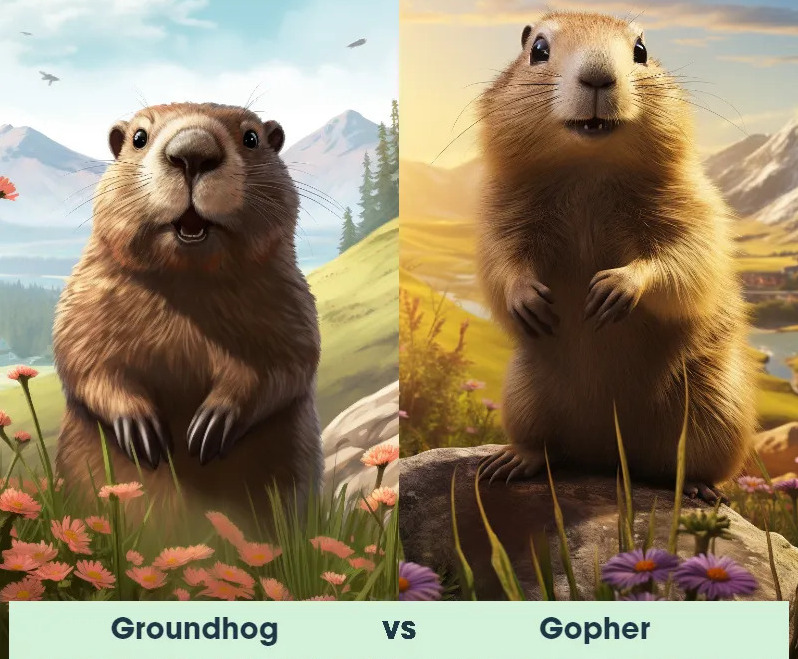When it comes to burrowing rodents, gophers and groundhogs are often confused due to their similar appearances and behaviors. However, these two animals have distinct differences in terms of size, diet, habitat, and behavior. Understanding these differences can help you identify each species and appreciate their roles in the ecosystem. In this article, we will delve into the characteristics of gophers and groundhogs, highlighting their unique traits and offering a comparison table for clarity.

Gophers, belonging to the family Geomyidae, are small to medium-sized rodents known for their extensive burrowing habits. They are primarily herbivorous, feeding on roots, tubers, and other plant materials. Gophers are typically found in North America and are recognized for their cheek pouches, which they use to store food.
Groundhogs, also known as woodchucks, belong to the family Sciuridae and are much larger than gophers. They are primarily herbivores but also occasionally eat insects. Groundhogs are commonly found in North America and are known for their robust bodies and distinctive burrows.
| Feature | Gophers | Groundhogs |
|---|---|---|
| Size | 5 to 14 inches (13 to 36 cm) | 16 to 26 inches (40 to 66 cm) |
| Weight | 1 to 3 pounds (0.5 to 1.4 kg) | 5 to 14 pounds (2.3 to 6.4 kg) |
| Appearance | Small, stocky body; short tail; large incisors; small eyes and ears | Larger, robust body; bushy tail; strong limbs; small ears |
| Diet | Herbivorous (roots, tubers) | Herbivorous (grasses, leaves) but occasionally eat insects |
| Habitat | Grasslands, open fields, gardens | Forest edges, fields, and suburbs |
| Burrowing Style | Complex tunnel systems, often near the surface | Deep burrows with multiple entrances |
| Social Behavior | Generally solitary | Social, often seen in groups during the summer |
| Predators | Birds of prey, snakes, and mammals | Coyotes, foxes, and domestic animals |
| Hibernation | Do not hibernate | Hibernates during winter months |
Gophers are much smaller than groundhogs. Adult gophers typically weigh between 1 to 3 pounds and measure 5 to 14 inches long, while groundhogs can weigh anywhere from 5 to 14 pounds and reach lengths of 16 to 26 inches. This size difference makes groundhogs more noticeable in their environments.
Gophers have a stocky body with a short tail and large incisors that are used for digging and feeding. Their small eyes and ears reflect their underground lifestyle. Groundhogs, on the other hand, have a more robust build, bushy tails, and a broad head. Their appearance is similar to that of a small bear, with thicker limbs suited for digging.
Both gophers and groundhogs are primarily herbivorous, but their diets vary slightly. Gophers mainly consume roots and tubers, while groundhogs feed on a wider range of vegetation, including grasses, leaves, and occasionally insects. Groundhogs are also known to damage gardens and crops, making them a more significant pest in agricultural areas.
Gophers are typically found in grasslands, open fields, and gardens where they can easily dig their tunnels. Groundhogs prefer forest edges, fields, and suburban areas where they can find ample food and shelter. Their burrowing habits create different types of disturbances in the soil and landscape.
Gophers create complex tunnel systems that are often located just below the soil surface, allowing them to access food sources efficiently. Groundhogs dig deep burrows with multiple entrances that can be several feet underground, providing protection from predators and harsh weather.
Gophers tend to be solitary creatures, often living alone in their burrows. Groundhogs, however, can be more social, particularly in the summer, when they are seen foraging in groups. This difference in social behavior affects their interaction with the environment and with other species.
Both gophers and groundhogs face predation from various animals. Gophers are preyed upon by birds of prey, snakes, and small mammals. Groundhogs, due to their larger size, have fewer natural predators, primarily facing threats from coyotes, foxes, and domestic pets.
One of the most notable differences is that gophers do not hibernate, remaining active year-round. In contrast, groundhogs hibernate during the winter months, entering a state of dormancy to conserve energy when food is scarce.
In summary, while gophers and groundhogs may share some similarities as burrowing rodents, they possess distinct characteristics that set them apart. From their size and appearance to their diets and behaviors, understanding these differences is essential for anyone interested in wildlife or managing garden pests. With this comprehensive comparison, you can now better appreciate the unique traits of gophers and groundhogs in their natural habitats.
animal tags: Gophers Groundhogs
We created this article in conjunction with AI technology, then made sure it was fact-checked and edited by a Animals Top editor.